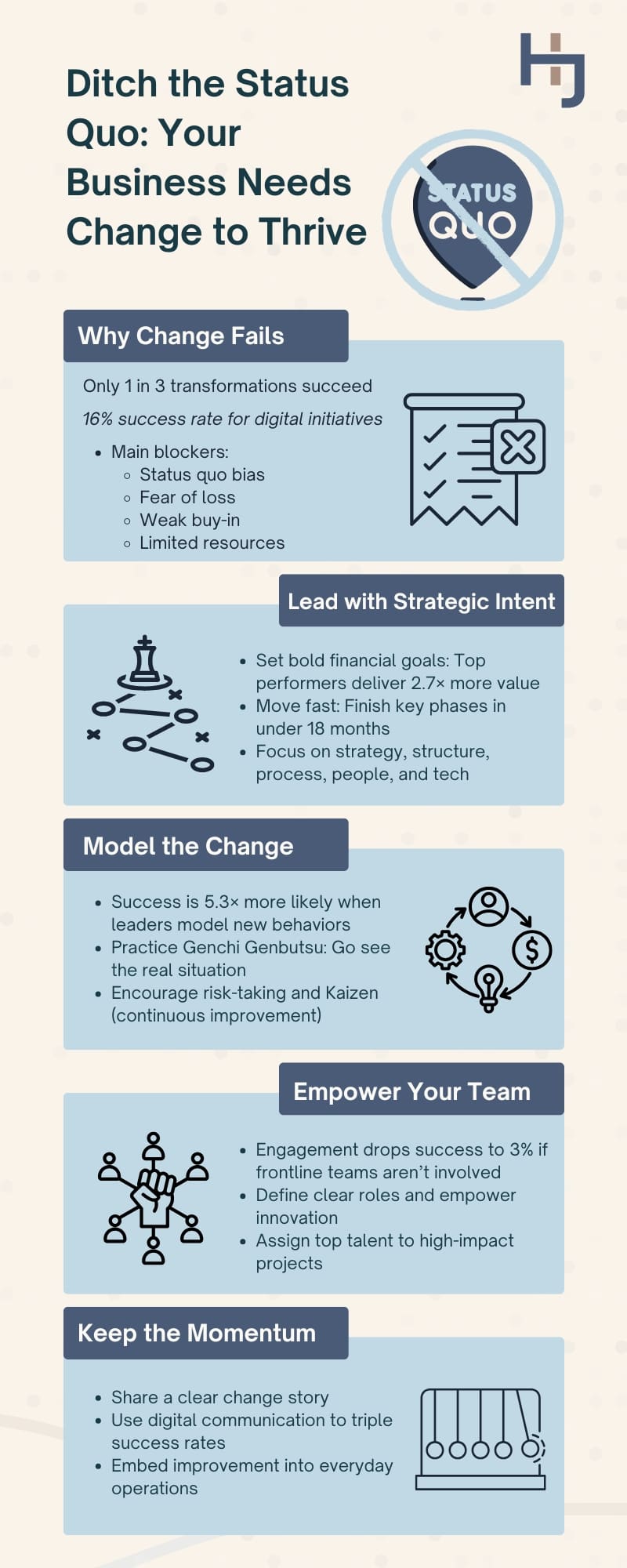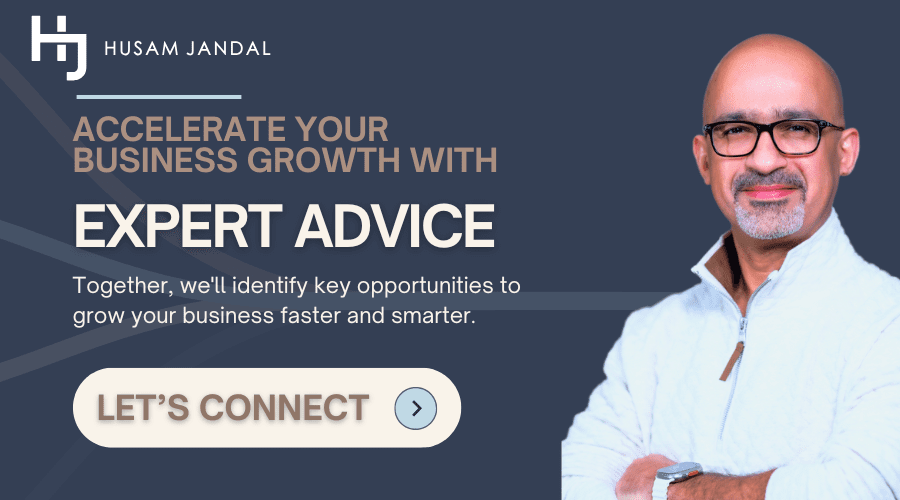 Developing a business transformation strategy? We’ve all heard the phrase, “Old habits die hard.” It probably fades into the background with other oft-cited bits of conventional wisdom until you’re actively trying to change something. It’s only then that we’re reminded that cultivating change is inherently difficult. It forces us to go against the very nature of how our brains are primed to function and navigate external barriers, too. The challenges are amplified when you’re trying to bring about change at an organizational level. But rest assured, change is valuable. In fact, building a culture that embraces change is essential to the long-term health and success of your business.
Developing a business transformation strategy? We’ve all heard the phrase, “Old habits die hard.” It probably fades into the background with other oft-cited bits of conventional wisdom until you’re actively trying to change something. It’s only then that we’re reminded that cultivating change is inherently difficult. It forces us to go against the very nature of how our brains are primed to function and navigate external barriers, too. The challenges are amplified when you’re trying to bring about change at an organizational level. But rest assured, change is valuable. In fact, building a culture that embraces change is essential to the long-term health and success of your business.
In this guide, we’ll explore the psychological and operational barriers that prevent businesses from making essential changes, so it’s easier to identify what’s holding you back, dig into the dangers of the status quo, and walk through what you can do to cultivate meaningful change in your company.
Change Resistance Has Deep Roots and Real-World Causes
People and organizations are naturally wired to favor stability, even when improvement is possible. Understanding why that happens is the first step toward leading change with confidence.
Familiarity Brings Comfort and Puts Us on Autopilot
In psychology, the tendency to be drawn to the familiar is known as status quo bias. Simply put, people overwhelmingly prefer existing conditions, even when better alternatives are available, as Harvard University research shows. The reason lies in how the brain rewards predictability.
When you recognize a familiar pattern, your brain releases small amounts of dopamine, reinforcing the behavior and creating a sense of safety. Over time, this becomes habit. Once a routine is ingrained, it shifts to the basal ganglia, which makes it automatic, per MIT.
You probably experience this in all sorts of ways in your daily life. You don’t need to think about how to make coffee, drive to work, or wash dishes. You just do it. Moreover, if you have a certain process for doing something, doing anything else feels “wrong.” For instance, when you drive to the store, you probably get a surge of dopamine when “your” parking spot is available. But if you have to park in an area you’re not used to, it probably feels uncomfortable.
In business, those “automatic” processes also become culture. They define how teams operate and make the old way feel like the right way.
We’re Wired to Fear Loss and Failure
One of the strongest psychological forces in business decision-making is loss aversion. People actually feel the pain of a loss twice as intensely as the satisfaction of a gain, according to Columbia University.
For business owners and leaders, that means the potential downside of change can feel far riskier than the upside of innovation. If you’ve built your company from the ground up, protecting what you’ve achieved is instinctive. The irony is that avoiding risk entirely can create a different kind of loss, which we’ll explore in just a moment.
We Have Limited Mental Bandwidth and Are Prone to Decision Fatigue
Have you ever noticed how, at the end of a long day, you’ll do things or agree to things that you’d ordinarily decline, simply because you feel “done?” There’s a psychological reason for this, too. Willpower is finite. Moreover, every choice you make depletes willpower and cognitive energy. The more decisions you face in a day, the harder it becomes to evaluate new information objectively, studies show.
This results in what psychologists call cognitive overload. When that happens, the brain defaults to familiar patterns simply to conserve energy. At work, you might recognize this in yourself when you postpone a project that requires deep thinking or revert to a proven but aging strategy because it feels easier to manage.
Data is Underleveraged

Many leaders view themselves as data-driven. However, when faced with a decision, the majority still lean on intuition or borrow strategies from large, established brands, as Knowable reports.
There are several reasons for this. Gathering data can seem resource-intensive and slow, which feels unrealistic when attention is on what will move the needle this quarter. Even when data exists, many leaders lack the time or training to interpret it effectively.
These challenges push decision-making back into default mode, where the psychological forces we’ve discussed take over. The safe, comfortable, and familiar path wins out, while opportunities for innovation remain just out of reach.
Teams Don’t Buy In
Even when leadership is convinced, a change can stall if teams are not aligned. Roughly 70 percent of change programs fail, according to McKinsey. The greatest barriers are employee resistance and a lack of management support. Getting people invested is key, and it can boost success by as much as 30 percent.
However, the advice that’s typically repeated here is to communicate the change and the reasons for it. This is simply not enough. In fact, it can backfire, research published by the American Psychological Association shows. Instead, organizations must build a culture that fosters buy-in with specific components, such as ownership and authenticity, to build change readiness, according to organizational change expert Andrea Belk Olson.
Resources Are Finite
Even if you’re committed, are leveraging a data-driven approach, and have your team on board, progress can still stall due to limited bandwidth. Nearly 60 percent of executives say competing priorities are a barrier to large-scale transformation, per Deloitte surveys.
Maintaining the Status Quo Can Be Dangerous
Now that we’ve explored why your business is probably stuck, let’s dig into what happens behind the scenes when a business maintains the status quo.
Competitive Position Weakens
Markets evolve whether your business does or not. Customer expectations shift, technology advances, and competitors find new ways to deliver value. What once felt modern quickly becomes routine, and routine eventually becomes outdated.
Over time, this erodes your competitive position. Companies that emphasize innovation consistently grow faster than those that do not by as much as 16 percent over three years, according to PwC. When others move ahead, your products start to feel dated, your processes slow down, and even loyal customers begin exploring fresher alternatives.
Agility Declines
Processes that once created efficiency can eventually slow progress. Over time, approvals, routines, and legacy systems start adding friction instead of removing it. Projects that should move quickly often take longer to complete, and opportunities are lost while people navigate the process.
Meanwhile, organizations using agile practices operate up to ten times faster than those relying on traditional structures, according to McKinsey. The difference comes down to flexibility. When systems are designed to adapt, decisions flow and teams move. When they aren’t, even small shifts can seem insurmountable.
Innovation Becomes Reactive Instead of Strategic
When change only happens in response to crisis, innovation shifts from proactive to reactive. Teams focus on fixing immediate problems instead of pursuing long-term opportunities.
For instance, many businesses only embraced digital transformation after the pandemic forced them to operate remotely. Those who had already invested in new technology adapted quickly and even grew, while those who hadn’t were left scrambling.
Culture Erodes
A culture that discourages experimentation also discourages engagement. Employees who see that new ideas rarely gain traction become less likely to contribute them. Over time, creativity fades and morale drops. Organizations with low engagement experience 18 percent lower productivity and 23 percent lower profitability, per Gallup research.
Growth Becomes Unsustainable
Ultimately, resistance to change creates a slow leak in the business. Revenue may hold steady for a while, but costs rise as inefficiencies accumulate. Decision-making slows. Customer satisfaction dips. By the time performance metrics reveal the decline, catching up is exponentially harder.
Lead with Strategic Intent to Help Your Business Change, Grow, and Thrive
Transformation is inherently difficult. Large-scale change efforts, like organizational transformations, have a success rate persistently below one-third, as McKinsey reports. Digital transformations are even more elusive, with success rates falling as low as 16 percent. To launch and sustain change initiatives that improve performance, you must commit to leading with unambiguous strategic intent.
Too often, business leaders think of “strategy” as a list of goals, such as increasing market share or reducing operating costs. However, it is better defined as the unique and distinct method by which those goals are achieved. It must be core to your organizational identity and flexible enough to adapt, whether you are pursuing growth or reinvention. The following proven strategies will help you transition from undergoing change to actively leading a thriving transformation.
Define Value and Set the Pace for Transformation
To ensure your efforts capture maximum value, you must prioritize the transformation from day one.
Determine the Full Financial Potential
Begin by completing a comprehensive, fact-based assessment of the business to identify all potential opportunities for improvement. It’s important to set an overall, ambitious financial target for the transformation, as companies that set high expectations tend to meet them, often delivering 2.7 times more value than senior executives initially thought possible, McKinsey research shows. Value loss can begin as early as the target-setting phase, so be bold and intentional about what is possible.
Embrace Speed and Momentum
The organizations that achieve highly successful agile transformations complete the main phase in less than 18 months, according to McKinsey. Taking longer than this increases the risk of exhausting the organization and reduces your chances of success. Use front-runners, or intentional efforts to test the full new operating model in a specific area, early on, to secure wins and demonstrate commitment.
This is the approach I leverage in my Digital Marketing Tree methodology, which blends foundational activities, such as fortifying your website, with quick wins like pay-per-click (PPC) ads, so you can start enjoying the fruits of your efforts early. We also develop a tactical plan outlining all the steps involved in the transformation. Depending on the size of the business, present status, goals, and resource allocation, full deployment typically takes between 6 and 18 months.
Upgrade the Organization’s Hard Wiring
Enterprise-wide change requires rewiring the entire operating model across strategy, structure, processes, people, and technology. Focusing on only one element, such as launching new technology or implementing culture initiatives, will often create friction between the old and new ways of working.
Lead by Example and Demand Digital Savvy

Success requires active leadership involvement and modeling the changes you wish to see across the organization.
Ensure Leadership Readiness
Before launching any major change, the leadership team must have a deep understanding of what the transformation means at scale that goes beyond basic awareness. Senior leaders should model desired behavior changes and must be dedicated to the effort, as this makes it 5.3 times more likely that your business will succeed. For instance, if you have goals that involve cross-selling or soliciting referrals, your team should hear you doing these things as you converse with your clients. If you want them to use a new tool, such as a project management system, they should see you active in it as well.
Practice Genchi Genbutsu
“Genchi genbutsu” loosely translates to “the situation onsite.” Popularized as one of the core principles of the Toyota Production System, which gained fame for improving efficiency and quality, the idea simply means you should see things with your own eyes. Don’t assume you know how the organization works or rely on secondhand accounts. Go and see for yourself to thoroughly understand complex or troublesome processes firsthand, as it will prove invaluable when solving root problems and driving organizational learning.
This is also something I apply as a business and digital marketing consultant. While I can often diagnose issues by talking to teams and reviewing reports, I’ve also been known to hop on a plane and physically visit the locations in which my clients operate.
As a business owner or leader with boots on the ground, you have a distinct advantage here. Spend some time simply observing all your processes as they naturally unfold without trying to change anything. That may mean sitting on your sales floor for a day, listening to the calls, and watching how your team works, or heading down to a production floor or warehouse to see what’s really happening.
Cultivate a New Mindset
Start by ensuring you have the right people in place, particularly in your leadership team. You want people who are tech-savvy, experts in their domain, and the embodiment of what you want to see in your organization.
If your existing team is weak in any of these areas, see if you can put together individual action plans that will help them become what your business needs them to be. Investing in them this way often builds enthusiasm for the road ahead and boosts loyalty, both of which will help you reach your goals. At the same time, it’s essential to be honest when someone’s skills and behaviors don’t align with the future you envision. Consider moving long-term trusted team members to new roles in these situations or helping them transition to a role that’s a better fit elsewhere when a more suitable internal role is not available.
It’s also worth noting that leaders in successful transformations encourage calculated risk-taking and experimentation, such as rapid prototyping, and allow employees to learn from their failures. They actively encourage employees to challenge old ways of working.
As you try to emulate this in your business, you can open the floor to new ideas with employee surveys or by asking open-ended questions in meetings and one-on-ones. Show appreciation for all ideas, even those that aren’t a good fit or well-developed, and celebrate experimentation, even when tests fail. By creating the kind of environment where joy is found in experimentation, rather than results alone, your team learns it’s safe to fail, creativity improves, and stronger ideas are generated.
Engineer True Ownership and Perpetual Improvement
Another gem from Toyota is the idea of “Kaizen,” which refers to continuous improvement. It simply means that the team is aware of how their work impacts the business as a whole and continuously looks for ways to add value by improving quality, eliminating waste, and increasing efficiency. To build this type of culture, explore ways to improve employee buy-in and organizational engagement.
Focus on Behaviors, Not Just Process
Lasting and sustainable change is achieved by influencing and reinforcing the right behaviors. Ensure employees understand how the change benefits them personally, for the team, and for the organization.
Define Clear Roles and Empower the Front Line
Success rates plummet to only three percent when frontline employees and line managers are not engaged, McKinsey research shows. You must clearly define individuals’ roles and responsibilities, so they align with the transformation’s goals. Beyond defining roles, empower employees by allowing them to generate their own ideas about where change or digitization might support the business.
Allocate Your Most Capable Talent to High-Impact Opportunities
In smaller and mid-sized businesses, every leader has a high-impact role, and every employee’s time is a finite resource. True transformation cannot happen if your best people are bogged down in routine tasks or minor projects. Transformation success is significantly more likely when organizations deploy their best talent to carry out the most critical parts of the transformation. Link your business priorities directly to your talent strategy. This means:
- Identify Your Highest-Impact Initiatives: Pinpoint the initiatives that will fundamentally change how your business runs or delivers a new competitive advantage. Whether adopting a new technology, streamlining a critical end-to-end process, or launching a key service, these are the projects where the return on time investment is greatest.
- Assign the Right People: Match your most experienced, high-potential, and enthusiastic employees to lead and drive these crucial projects. These are the individuals who have the skills and experience to deliver the desired results.
- Protect Their Bandwidth: To maximize results, keep your key contributors focused on these biggest, most visible initiatives. Overloading them with too many responsibilities risks delaying value capture and exhausting their energy. For smaller changes, involve a wider coalition of employees to build broader engagement and buy-in across the company.
Communicate Continuously and Creatively
Communicate a clear change story that helps employees understand where the organization is headed, why it is changing, and why the changes are important. Successful organizations are more likely to use digital and remote channels, such as internal social media, to convey the vision, which can triple the success rate compared to in-person or traditional channels, per McKinsey.
Embed Change into Business-as-Usual
A transformation does not end when initiatives are executed. To mitigate value loss and sustain improvements, you must embed transformation disciplines, such as substantial changes to annual business-planning and review cycles, into your “business as usual” structures. This is one of the fundamentals of Kaizen, and it’s critical for long-term organizational health and prevents backsliding on performance gains.
Get Help Building Business Growth Through Change
One of the key reasons I enjoy working with small and mid-sized companies the most as a business and digital marketing consultant is that the owners and leadership teams are hungry for change. You also have an advantage over larger companies in that your decision-making process is streamlined. While you likely have an approval process, it doesn’t take a month for a decision to gain approval and be routed through legacy channels. This is a major strategic advantage because it means you can gain ground very quickly once things start moving.
If your business is starting to feel weighed down by legacy processes or your growth is stalled, I can help by building you a tailored business transformation strategy that aligns marketing, sales, and operations, removes silos, and fortifies your company from the ground up. If you’d like to explore what this might look like for your business, request a complimentary consultation.
FAQs on Creating and Leading a Successful Business Transformation Strategy
Why is the status quo dangerous for business?
Maintaining the status quo weakens competitive position over time. Markets evolve, technology advances, and customer expectations shift. Businesses that don’t adapt see declining agility, slower decision-making, and eroding culture. Research shows innovative organizations grow faster and sustain stronger margins, while those that resist change risk falling behind more adaptable competitors.
What are the risks of not adapting to change?
Failing to adapt limits growth, invites operational inefficiency, and reduces long-term profitability. Processes that once created stability eventually add friction. When change only happens in crisis, innovation becomes reactive instead of strategic. Over time, culture, morale, and customer loyalty deteriorate, making recovery increasingly difficult and costly.
How can leaders promote innovation in stagnant organizations?
Leaders foster innovation by modeling openness, rewarding experimentation, and aligning each initiative with measurable business outcomes. Building ownership and authenticity within teams encourages participation and creativity. McKinsey research shows transformation success rises sharply when leadership demonstrates commitment, sets clear goals, and empowers employees to test and refine new ideas.
What prevents companies from embracing transformation?
Change often stalls due to psychological bias, limited resources, and lack of alignment. Leaders may lean on intuition rather than data, teams resist unfamiliar processes, and competing priorities divert attention. True transformation requires clear direction, cultural readiness, and leadership that models the behavior and mindset it expects from others.
How does resisting change affect long-term growth?
Resistance creates hidden drag. Revenue may remain stable initially, but costs rise and customer satisfaction declines as inefficiencies grow. Gallup data links low engagement to drops in productivity and profitability, while PwC finds innovative firms achieve stronger, faster growth. Standing still eventually undermines the foundation of sustainable success.
What are examples of businesses that failed due to inaction?
Countless case studies highlight the cost of complacency. Once-dominant brands like Blockbuster and Kodak hesitated to pivot despite clear market signals. Their reliance on outdated models illustrates how the comfort of familiarity can blind leaders to disruption, allowing faster, more agile competitors to capture the market.
How do you build a culture that embraces change?
A change-ready culture grows through ownership, authenticity, and reinforcement. Encourage input from all levels, celebrate experimentation—even when tests fail—and connect change efforts to meaningful outcomes. Gallup and Deloitte research show that engagement, skill development, and recognition drive sustained adoption far more effectively than top-down directives alone.
What frameworks support successful transformation?
Proven frameworks combine strategic clarity with cultural alignment. McKinsey’s research emphasizes setting ambitious value targets and embedding progress into daily operations. Toyota’s Kaizen and Genchi Genbutsu highlight continuous improvement and firsthand learning. The Digital Marketing Tree applies these same principles by pairing foundational business work with quick, measurable wins to drive sustainable transformation.
How do I shift legacy mindsets in senior teams?
Model curiosity and continuous learning at the top. Encourage leaders to spend time observing real workflows (“go and see”) and invite open dialogue about process pain points. By tying transformation goals to shared performance metrics and personal accountability, legacy mindsets give way to collective ownership and adaptability.
Is incremental change enough in a fast-moving market?
Incremental improvements maintain stability but rarely deliver a competitive advantage. McKinsey reports that organizations completing major transformations within 18 months achieve stronger results than those that move slowly. A balanced approach, combining quick wins with bold, well-paced initiatives, helps you maintain momentum without overwhelming teams or exhausting resources.
What is strategic business adaptation?
Strategic business adaptation is the deliberate, data-informed process of aligning operations, technology, and culture to evolving market conditions. It means linking change to measurable outcomes and embedding flexibility into daily management so the organization can shift direction quickly while still advancing toward long-term goals.
What is the OCM methodology?
Organizational Change Management (OCM) is a structured approach that ensures transformations meet business objectives by addressing the human side of change. It focuses on preparing, equipping, and supporting individuals to adopt new behaviors, reducing resistance, and embedding new ways of working into the organization’s culture.
What are the core change leadership principles?
Effective change leadership rests on clarity, credibility, and consistency. Leaders define clear value goals, communicate transparently, and model desired behaviors. They build trust through action, empower others to contribute, and create systems that reinforce progress so that transformation becomes a continuous, organization-wide capability rather than a one-time event.





































































